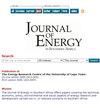南非可再生能源开发区风力资源数据聚类
IF 0.6
4区 工程技术
Q4 ENERGY & FUELS
引用次数: 7
摘要
本研究探讨了聚类方法的使用,将时空风速数据简化为具有统计代表性的时间剖面类,以便进一步处理和解释。聚类方法应用于科学和工业研究理事会为南部非洲制作的高分辨率时空、中尺度可再生能源数据集。这个大型数据集包含数千个坐标,从计算的角度来看是一个挑战。该数据集可以通过应用聚类技术将时间风速廓线分类为具有相似统计属性的类别来简化。考虑了各种聚类算法,比较了这些算法在大型风资源数据集上的性能,即k-means、围绕介质的划分、聚类大应用算法、聚类聚类、分裂分析算法和模糊c-means聚类。考虑了两种距离度量,即欧几里得距离和Pearson相关距离。在调查中评估的验证指标包括轮廓系数、Calinski-Harabasz指数和Dunn指数。本文介绍了位于南非西开普省的Komsberg可再生能源开发区的案例研究结果。该区域的选择是基于该区域相关的时间风速廓线所显示的高平均风速和大标准差。通过根据Megaflex使用时间关税定义的低需求季节和高需求季节划分输入数据集,考虑了季节变化对时间风速廓线的影响。该方法生成的聚类风资源图为进一步研究提供了有价值的输入数据集,例如风力发电能力的选址和最佳地理分配,以减少风能固有的可变性和斜坡效应。本文章由计算机程序翻译,如有差异,请以英文原文为准。
Clustering of wind resource data for the South African renewable energy development zones
This study investigates the use of clustering methodologies as a means of reducing spatio-temporal wind speed data into statistically representative classes of temporal profiles for further processing and interpretation. The clustering methodologies are applied to the high-resolution spatio-temporal, meso-scale renewable energy resource dataset produced for Southern Africa by the Council of Scientific and Industrial Research. This large dataset incorporates thousands of coordinates and represents a challenge from a computational perspective. This dataset can be reduced by applying clustering techniques to classify the temporal wind speed profiles into categories with similar statistical properties. Various clustering algorithms are considered, with the view to compare the performances of these algorithms for large wind resource datasets, namely k-means, partitioning around medoids, the clustering large applications algorithm, agglomerative clustering, the divisive analysis algorithm and fuzzy c-means clustering. Two distance measures are considered, namely the Euclidean distance and Pearson correlation distance. The validation metrics evaluated in the investigation includes the silhouette coefficient, the Calinski-Harabasz index and the Dunn index. Case study results are presented for the Komsberg Renewable Energy Development Zone, located in Western Cape, South Africa. This zone is selected based on the high mean wind speed and large standard deviation exhibited by the temporal wind speed profiles associated with the zone. The effects of seasonal variation in the temporal wind speed profiles are considered by partitioning the input dataset in accordance with the low and high demand seasons defined by the Megaflex Time of Use tariff. The clustered wind resource maps produced by the proposed methodology represent a valuable input dataset for further studies such as siting and the optimal geographical allocation of wind generation capacity to reduce the variability and ramping effects that are inherent to wind energy.
求助全文
通过发布文献求助,成功后即可免费获取论文全文。
去求助
来源期刊

Journal of Energy in Southern Africa
ENERGY & FUELS-
CiteScore
3.00
自引率
0.00%
发文量
16
审稿时长
6 months
期刊介绍:
The journal has a regional focus on southern Africa. Manuscripts that are accepted for consideration to publish in the journal must address energy issues in southern Africa or have a clear component relevant to southern Africa, including research that was set-up or designed in the region. The southern African region is considered to be constituted by the following fifteen (15) countries: Angola, Botswana, Democratic Republic of Congo, Lesotho, Malawi, Madagascar, Mauritius, Mozambique, Namibia, Seychelles, South Africa, Swaziland, Tanzania, Zambia and Zimbabwe.
Within this broad field of energy research, topics of particular interest include energy efficiency, modelling, renewable energy, poverty, sustainable development, climate change mitigation, energy security, energy policy, energy governance, markets, technology and innovation.
 求助内容:
求助内容: 应助结果提醒方式:
应助结果提醒方式:


